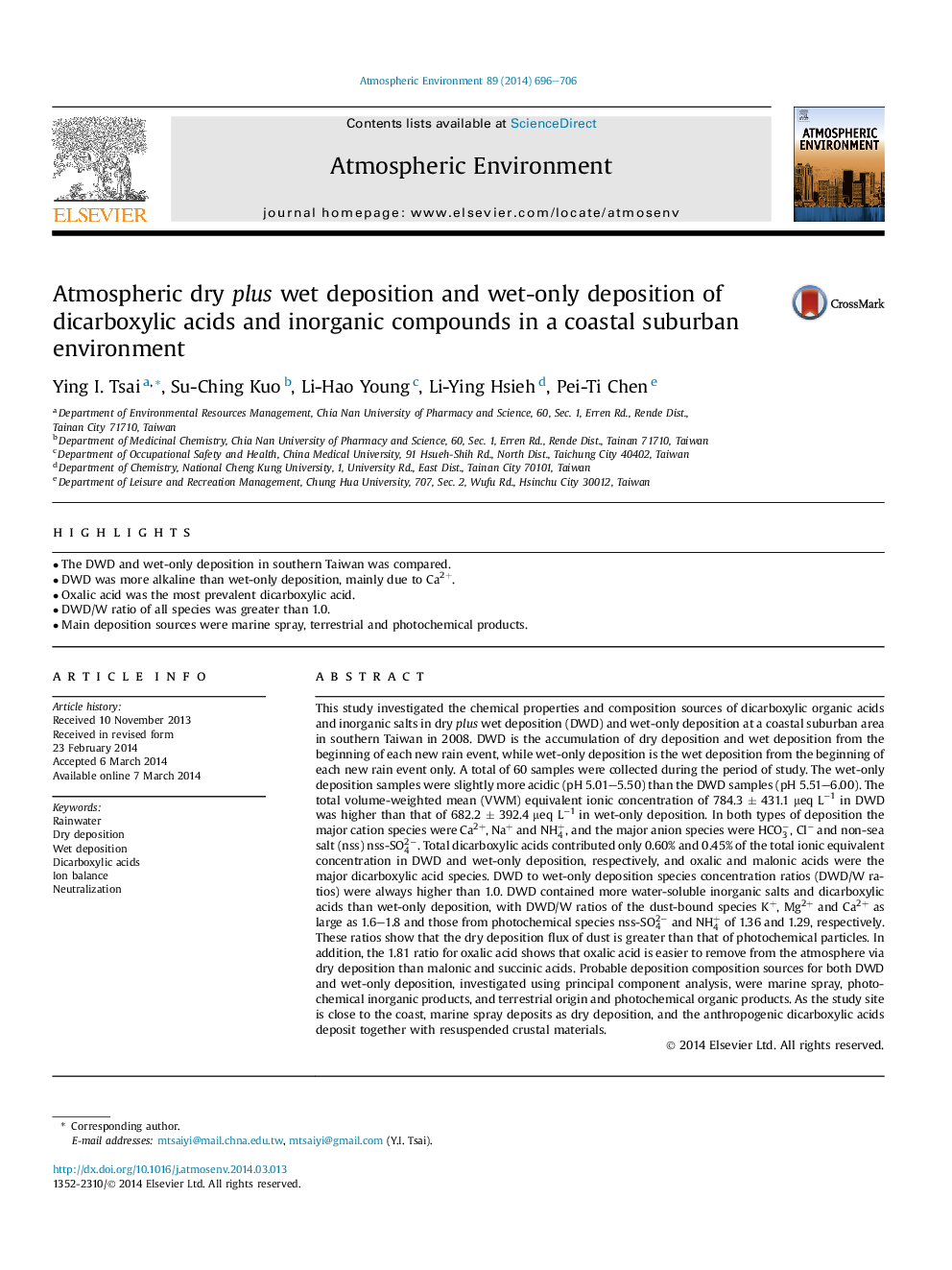| کد مقاله | کد نشریه | سال انتشار | مقاله انگلیسی | نسخه تمام متن |
|---|---|---|---|---|
| 6340296 | 1620382 | 2014 | 11 صفحه PDF | دانلود رایگان |
عنوان انگلیسی مقاله ISI
Atmospheric dry plus wet deposition and wet-only deposition of dicarboxylic acids and inorganic compounds in a coastal suburban environment
دانلود مقاله + سفارش ترجمه
دانلود مقاله ISI انگلیسی
رایگان برای ایرانیان
کلمات کلیدی
موضوعات مرتبط
مهندسی و علوم پایه
علوم زمین و سیارات
علم هواشناسی
پیش نمایش صفحه اول مقاله

چکیده انگلیسی
This study investigated the chemical properties and composition sources of dicarboxylic organic acids and inorganic salts in dry plus wet deposition (DWD) and wet-only deposition at a coastal suburban area in southern Taiwan in 2008. DWD is the accumulation of dry deposition and wet deposition from the beginning of each new rain event, while wet-only deposition is the wet deposition from the beginning of each new rain event only. A total of 60 samples were collected during the period of study. The wet-only deposition samples were slightly more acidic (pH 5.01-5.50) than the DWD samples (pH 5.51-6.00). The total volume-weighted mean (VWM) equivalent ionic concentration of 784.3 ± 431.1 μeq Lâ1 in DWD was higher than that of 682.2 ± 392.4 μeq Lâ1 in wet-only deposition. In both types of deposition the major cation species were Ca2+, Na+ and NH4+, and the major anion species were HCO3â, Clâ and non-sea salt (nss) nss-SO42â. Total dicarboxylic acids contributed only 0.60% and 0.45% of the total ionic equivalent concentration in DWD and wet-only deposition, respectively, and oxalic and malonic acids were the major dicarboxylic acid species. DWD to wet-only deposition species concentration ratios (DWD/W ratios) were always higher than 1.0. DWD contained more water-soluble inorganic salts and dicarboxylic acids than wet-only deposition, with DWD/W ratios of the dust-bound species K+, Mg2+ and Ca2+ as large as 1.6-1.8 and those from photochemical species nss-SO42â and NH4+ of 1.36 and 1.29, respectively. These ratios show that the dry deposition flux of dust is greater than that of photochemical particles. In addition, the 1.81 ratio for oxalic acid shows that oxalic acid is easier to remove from the atmosphere via dry deposition than malonic and succinic acids. Probable deposition composition sources for both DWD and wet-only deposition, investigated using principal component analysis, were marine spray, photochemical inorganic products, and terrestrial origin and photochemical organic products. As the study site is close to the coast, marine spray deposits as dry deposition, and the anthropogenic dicarboxylic acids deposit together with resuspended crustal materials.
ناشر
Database: Elsevier - ScienceDirect (ساینس دایرکت)
Journal: Atmospheric Environment - Volume 89, June 2014, Pages 696-706
Journal: Atmospheric Environment - Volume 89, June 2014, Pages 696-706
نویسندگان
Ying I. Tsai, Su-Ching Kuo, Li-Hao Young, Li-Ying Hsieh, Pei-Ti Chen,